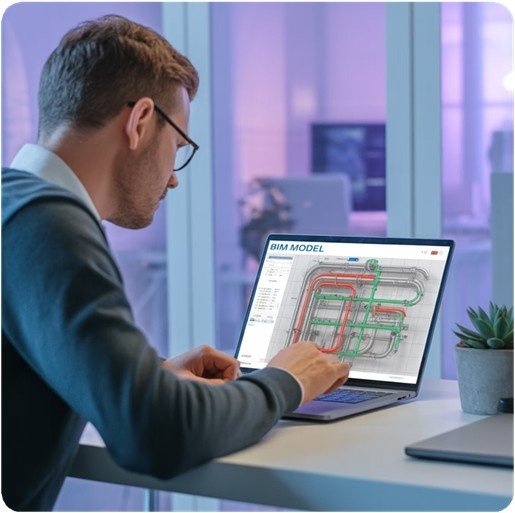Revolutionizing Construction: BIM Solutions for Subcontractors
In today’s evolving construction landscape, Building Information Modeling (BIM) is transforming how subcontractors plan, execute, and deliver projects. As specialized trade experts, subcontractors face unique challenges that modern BIM solutions can address—improving collaboration, reducing errors, and increasing profitability. Discover how BIM technology is becoming an essential tool for forward-thinking subcontractors.

Why Subcontractors Need BIM: Beyond Basic Modeling
Subcontractors often work at the critical intersection of design and practical implementation, making BIM especially valuable for their role. Traditional construction methods can lead to costly rework, schedule delays, and miscommunication between trades.
|
With BIM, subcontractors can:
|
|
As project owners increasingly require BIM deliverables, subcontractors who master these tools gain a competitive advantage when bidding on complex projects. While the transition may seem challenging, the long-term benefits quickly outweigh the initial investment.
Key BIM Benefits for Different Subcontractor Trades
| Mechanical, Electrical & Plumbing (MEP) MEP subcontractors see some of the greatest gains from BIM adoption. Complex systems can be coordinated in 3D space before fabrication, reducing field modifications by up to 90%. BIM also makes prefabrication opportunities clearer, allowing more work to be done in controlled shop conditions rather than on-site. |
Structural & Concrete BIM enables accurate reinforcement modeling, detailed foundation layouts, and precise quantity takeoffs. Structural subcontractors can verify load paths, detect design issues early, and coordinate with architectural elements—preventing costly mistakes during construction. |
| Specialty Trades From glazing and millwork to fire protection, specialty contractors benefit from BIM’s precise dimensional control and visualization tools. Installation sequences can be planned more effectively, minimizing on-site decision-making and improving quality control throughout the process. |
|
The shift from traditional 2D drawings to comprehensive BIM workflows isn’t just about keeping up with industry trends—it’s about fundamentally improving how subcontractors work. By tailoring BIM tools to their specific trade requirements, subcontractors can turn potential challenges into valuable opportunities.
Overcoming BIM Implementation Challenges for Subcontractors
Many subcontractors hesitate to adopt BIM due to perceived barriers. Here’s how these common concerns can be addressed:
| Cost Concerns While there is an upfront investment in software and training, BIM should be viewed as a business investment rather than an expense. Start with smaller projects to build capability before scaling up. Many subcontractors recover their costs within one or two projects through reduced rework and improved efficiency. |
|
| Skills Gap You don’t need to make a complete transformation overnight. Begin by upskilling key team members who can champion BIM adoption within your organization. Partnering with BIM consultants like Consac can accelerate this process through targeted training programs designed specifically for subcontractors. |
Integration Concerns Modern BIM platforms increasingly offer seamless integration with estimating, project management, and accounting software. This creates a continuous digital thread throughout your operations, improving connectivity and enhancing overall business intelligence. |
How Consac BIM Solutions Empower Subcontractors
At Consac, we understand the unique challenges subcontractors face when implementing BIM. Our specialized approach focuses on practical, trade-specific solutions rather than one-size-fits-all implementations.
Trade-Specific Templates
We’ve developed customized BIM templates for various subcontractor disciplines, eliminating the need to create modeling standards from scratch. These templates incorporate best practices specific to your trade, helping you accelerate your BIM adoption journey.
Targeted Training Programs
Our training is not generic—it’s based on the actual projects you work on. By using familiar examples, your team gains practical skills they can apply immediately to ongoing and upcoming projects, ensuring a smooth transition to BIM workflows.
Collaboration Support
We help improve coordination with general contractors and other trades through established BIM protocols and communication frameworks. This ensures your input is heard during coordination meetings and your requirements are clearly documented.
Scalable Solutions
Whether you’re a small specialty contractor or a large MEP firm, our solutions scale to your needs and budget. Start with essential BIM capabilities and expand as your expertise grows, ensuring sustainable adoption without overwhelming your team.
Ready to transform your subcontracting business with BIM? Contact Consac today to learn how our tailored solutions can address your unique challenges and give you a competitive edge in today’s construction marketplace.
What's Your Reaction?


















